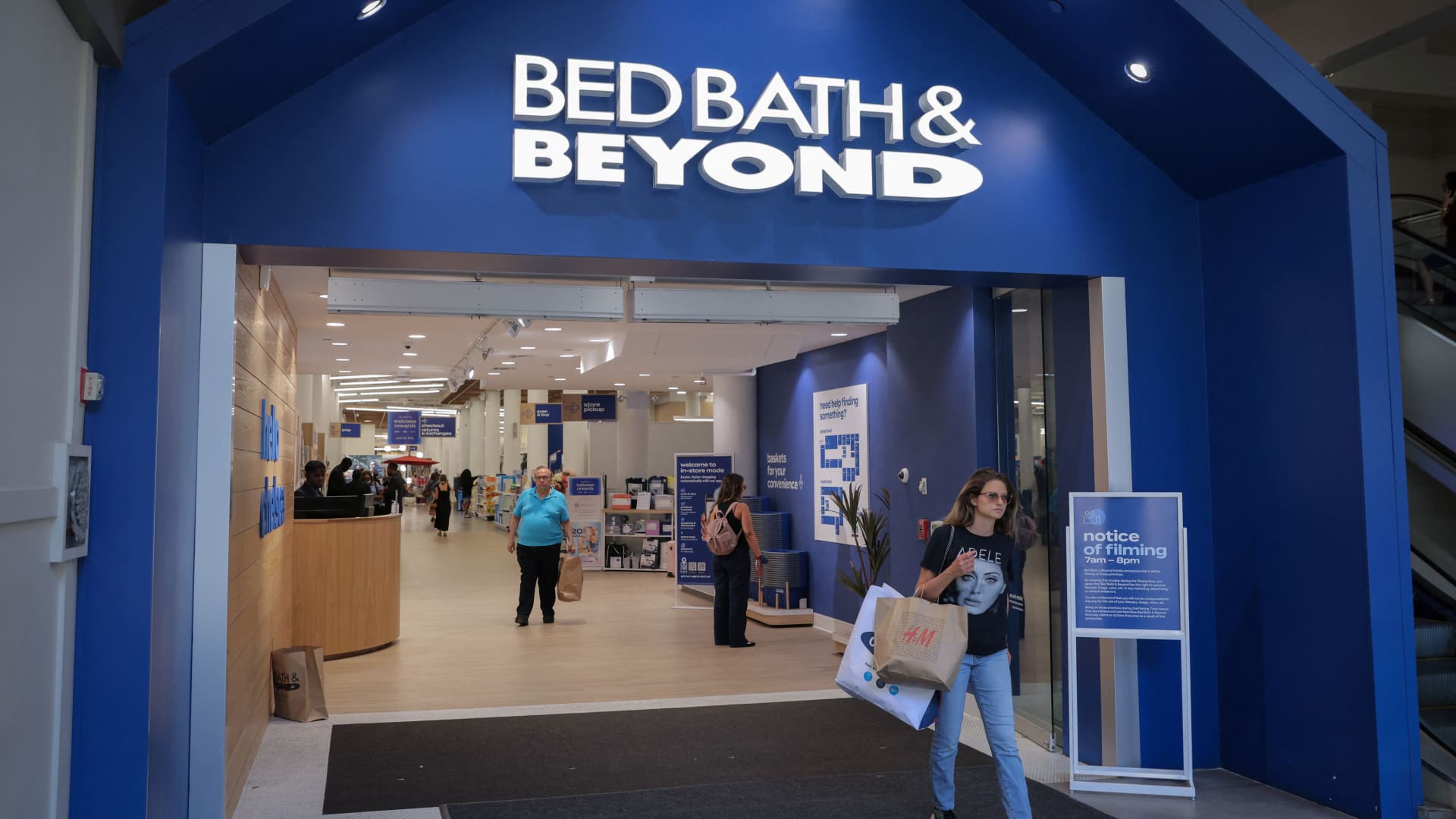Products You May Like
Bed Bath & Beyond is betting on a drastic change in strategy and well-recognized brands to revive its struggling business.
But the retailer’s strained relationships with suppliers of products such as air fryers and stand-mixers – some of which were missing from shelves two holiday seasons ago – could leave stores without hot items once again. Out-of-stock products could cripple Bed Bath’s already-declining sales and push the company toward bankruptcy.
related investing news
Bed Bath is fighting to win back customers as it contends with a leadership shakeup, a mountain of debt and the aftermath of a meme-stock frenzy fueled by activist investor Ryan Cohen. On top of that, tensions with merchandise suppliers grew as the company’s problems worsened, according to former executives who recently left the company. They declined to be named because they were not authorized to speak about internal discussions.
Chief Executive Mark Tritton, hired in 2019 to oversee the company’s previous turnaround effort, got ousted by the board this year. Bed Bath’s merchandising chief was also pushed out. Chief Financial Officer Gustavo Arnal, who was integral in lining up a new loan for Bed Bath, died by suicide earlier this month. The company is now led by an interim CEO and interim CFO.
On a call with investors in late August, two days before Arnal’s death, company leaders announced the fresh financing and revealed a new merchandising strategy that heavily relies on national brands to get more people into stores. Under Tritton, Bed Bath launched and tried to grow nine exclusive brands. Bed Bath now intends to sharply scale back those private labels – including discontinuing several.
Bed Bath has merchandise from its remaining store brands to fill shelves. It has deals with direct-to-consumer brands, such as mattress maker Casper, and is trying to court more of them. Yet to deliver on its new plan, Bed Bath must secure steady shipments from brands many shoppers recognize.
Bed Bath leaders say that the strategy shift has been well received. Interim CEO Sue Gove said in August that she’s even received thank you notes from vendors.
Read more retail coverage
“As previously shared, we are committed to delivering what our customers want, driving growth and profitability, and strengthening our financial position. We recognize the vital importance of our supplier partners and our team is working continuously with them, where support has been enthusiastic and high, particularly with our largest partners,” a company spokeswoman said in a statement.
“They want us to win, by supporting the assortment changes previously announced to create the best experience for our shared customers.” Bed Bath plans to give an update on its vendor relationships and strategies when it reports fiscal second quarter earnings next week, she added.
Over the past two years, however, Bed Bath has tested vendor relationships by making late payments, pushing aggressively into private labels and losing shoppers. Those tensions have intensified as financial troubles mounted, according to the former Bed Bath executives.
Make or break
Vendor relationships can make or break a retailer. Typically, suppliers ship goods and get reimbursed weeks or months later. The terms can change, however, if a retailer shows signs of financial distress – sometimes pushing a vendor to shorten the payment window, require cash on delivery or halt shipments.
Bed Bath has already agreed to tougher payment terms and advance payments for some suppliers, the company said in public filings. Company leaders acknowledged in a call with investors that it was managing vendor relationships on a week to week basis.
Tension with vendors is often a major reason retailers are pushed toward restructuring. Debt-burdened Toys “R” Us filed for bankruptcy in September 2017, and later liquidated, shortly after its suppliers demanded cash on delivery ahead of the holiday season. Other retailers, such as appliance chain H.H. Gregg and electronics store RadioShack, suffered a similar fate as they struggled to keep shelves stocked and burned through cash due to vendors’ tightened payment terms.
One factor working in Bed Bath’s favor is that it works with a vast number of vendors, and if needed, could replace one that wouldn’t ship to the retailer. Retailers like Toys “R” Us, as well as sporting goods chain Sports Authority – which liquidated as part of a bankruptcy filing in 2016 – were heavily reliant on very few suppliers to stock their shelves.
Bed Bath already had a significant debt load prior to the new financing. The retailer has a total of nearly $1.2 billion in unsecured notes – with maturity dates spread across 2024, 2034 and 2044 – which are all trading below par, a sign of its financial distress. In recent quarters, the company said it burned through significant amounts of cash. Despite this, it pressed ahead with an aggressive stock buyback plan that added up to more than $1 billion in repurchases.
The funding announced in August is expected to provide Bed Bath some breathing room and buy it some grace from vendors. But even before the company needed a loan, it lost standing with some of its suppliers, according to the former executives. Bed Bath has tussled with big-name vendors over terms of payment, and executives grew frustrated with smaller shipments of popular products, while seeing other retailers with more of that merchandise – and sometimes exclusive versions.
During the 2020 holidays, air fryers ran low across Bed Bath’s stores. KitchenAid stand mixers, a top item on Christmas lists and wedding registries, were out of stock. The few vacuums and hair styling tools from Dyson that arrived at stores quickly got shipped to online shoppers, leaving store displays bare. Yet at Amazon, Target and Best Buy, those same products were available – and in some cases, even at buzzy promotional prices.
KitchenAid parent company Whirlpool and Dyson didn’t respond to multiple requests for comment.
Growing troubles
Vendors and licensees, likewise, grew concerned by the pace of Bed Bath’s changes – particularly as the retailer launched its own brands of bedding, kitchen utensils and more. As some brands and manufacturers saw Bed Bath pare down orders quarter after quarter, they looked to other stores and websites.
The uneasy relationships exacerbated Bed Bath’s supply chain woes during the first two years of the pandemic, when all retailers coped with temporarily shuttered factories, congested ports and a shortage of truck drivers. The company lost $175 million in sales during the three months ended Feb. 26 as several items that were advertised in circulars were out of stock.
Vendors, which had limited supply, had to pick and choose where to send their hot products. As sales declined sharply at Bed Bath’s namesake stores, it had a harder time getting those items – such as Dyson’s hair styling tools or Keurig’s coffee makers– that were available at retail rivals, according to the former executives.
At company meetings, Bed Bath’s small shipments became a frequent theme – with merchandising leaders urging buyers to go to vendors and ask for more. There were also internal concerns that Bed Bath & Beyond was losing its clout and its relevance, the former executives said.
Bed Bath’s troubles have grown in recent months. Its stock has fallen about 50% this year, its market cap now at about $565 million.
About 60% of total net sales come from Bed Bath’s stores, but its footprint is shrinking. Last week, the company announced the first wave of approximately 150 store closures of its namesake brand. Including Harmon and BuyBuy Baby stores, the company went from nearly 1,500 stores at the end of the first quarter in 2020 to fewer than 1,000 stores at the end of the same period this year. As of February, Bed Bath had roughly 32,000 associates, including approximately 26,000 store associates and about 3,500 supply chain associates.
Meanwhile, the first wave of holiday merchandise has arrived at stores, including autumn wreaths, pumpkin-print kitchen towels and other fall-themed decor. Much of the merchandise at stores is from Bed Bath & Beyond’s private brands, such as budget-friendly home line Simply Essential.
During a CNBC visit in recent days, Bed Bath’s flagship store in New York City was full of clues that the retailer may not have enough of the hottest items. A Dyson display had six vacuum models – but only one type available for purchase. A display for French cookware company Le Creuset showed off Dutch ovens in many colors, but only had bright orange ones in stock.
Only one stainless-steel, step-on SimpleHuman garbage can, which retails for $149.99, was boxed and ready to be carried away. However, there were small plastic garbage cans from Bed Bath’s owned brand, spread across multiple rows – selling for $3 each.




